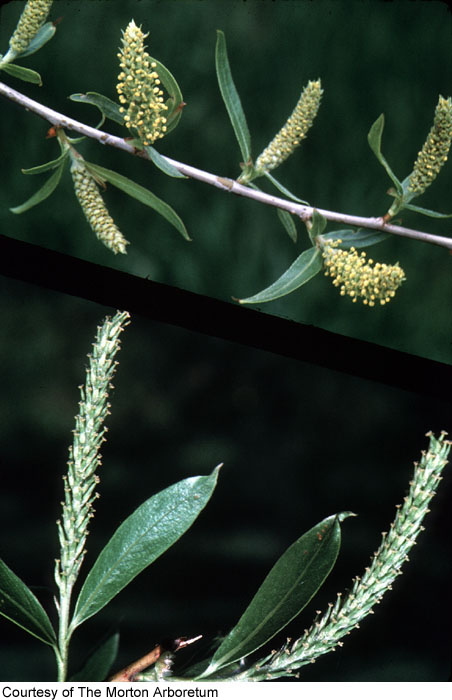Trees, 5-20+ m. Stems: branches highly brittle at base, red-brown to yellow-brown, glabrous; branchlets gray-brown to red-brown, glabrous or pilose to villous. Leaves: stipules rudimentary or foliaceous on early ones, usually foliaceous on late ones, (glands few or absent adaxially), apex acuminate, acute, or rounded; petiole (margins covering groove, with spherical glands distally), (2-)3-10(-15) mm, glabrous or pilose adaxially; largest medial blade (sometimes amphistomatous), very narrowly elliptic, lanceolate to narrowly lanceolate, or linear to lorate, (50-)70-103(-190) × (6-)7.5-17(-23) mm, 6-13 times as long as wide, base cuneate to convex, margins serrulate, apex acuminate, acute, or caudate, abaxial surface (not glaucous), glabrous or pilose, hairs white or ferruginous, wavy, adaxial slightly glossy, glabrous or pilose (especially on midribs); proximal blade margins serrulate; juvenile blade glabrous or pilose abaxially, hairs white and/or ferruginous. Catkins: staminate 35-83 × 7-13 mm, flowering branchlet 5-35 mm; pistillate 23-74(-80 in fruit) × 5-10 mm, flowering branchlet 6-35 mm; floral bract 1-3 mm, apex acute or rounded, entire, abaxially sparsely hairy, hairs wavy; pistillate bract deciduous after flowering. Staminate flowers: abaxial nectary 0.3-1 mm, adaxial nectary oblong to ovate, 0.2-0.6 mm, nectaries distinct or connate and shallowly cup-shaped; stamens 4-6; filaments hairy on proximal 1/2 or basally; anthers 0.4-0.6 mm, (axes strongly recurved). Pistillate flowers: adaxial nectary oblong, (swollen), 0.2-0.5 mm; stipe 0.5-1.5 mm; ovary pyriform to obclavate, (rarely pilose), beak slightly bulged below styles; ovules 12-16 per ovary; styles 0.1-0.3 mm; stigmas (sometimes 2 plump lobes), 0.2-0.28-0.36 mm. Capsules 3-5 mm. 2n = 38.
Flowering (south) early Feb-early May, (north) late Mar-early Jul. Floodplains, edges of ponds and lakes, swamps, marshes, white cedar bogs, wet meadows, open fields, roadside ditches, mixed upland deciduous woods along streams; 10-1400 m; N.B., Ont., Que.; Ala., Ark., Conn., Del., D.C., Fla., Ga., Ill., Ind., Iowa, Kans., Ky., La., Maine, Md., Mass., Mich., Minn., Miss., Mo., Nebr., N.H., N.J., N.Y., N.C., Ohio, Okla., Pa., R.I., S.C., Tenn., Tex., Vt., Va., W.Va., Wis.; Mexico (Chihuahua).
Hybrids:
Salix nigra forms natural hybrids with S. alba, S. amygdaloides, S. caroliniana, S. gooddingii, and S. lucida.
Medium-sized to large tree 12 - 25 m tall, trunk diameter 0.5 - 1 m
Leaves: alternate, on 3 - 6 mm long, hairy, gland-tipped leafstalks, green above, paler beneath, 8 - 15 cm long, 0.6 - 2 cm wide, narrowly lance-shaped with a rounded to tapering base and very long-pointed tip, curved, finely toothed, thin, shiny above, and hairy on the veins beneath.
Flowers: either male or female, borne on separate trees (dioecious) in cylindrical catkins. The catkin is hairy and grows on a short, leafy stalk. Female catkin greenish with yellow scales, 4 - 8 cm long. Ovary hairless. Male catkin 3 - 5 cm long, with yellow scales. Stamens three to seven, with yellow anthers.
Fruit: a capsule, in crowded, elongated clusters, stalked, reddish brown, 3 - 5 mm long, and flask-shaped. Seeds have long, white, silky hairs attached.
Bark: dark brown or nearly black, thick, and deeply furrowed with scaly, connecting ridges. Often becoming shaggy.
Twigs: slender, flexible, brittle at the base (especially young twigs), yellowish brown to reddish brown, becoming darker with age. Leaf scars U-shaped with three bundle scars each.
Buds: reddish brown, 2 - 5 mm long, narrow-conical, pointed, and shiny. Terminal bud absent.
Form: broadly rounded, irregular, and open. Trunk crooked and leaning, sometimes splitting into two or more stems.
Similar species: In the Chicago Region, Salix nigra differs from most other willows by having finely toothed leaves that are green, hairless (may have hairy veins on the lower surface), and not revolute (rolled downward along the margins). Salix eriocephala, S. lucida, and S. pentandra (willows with similar leaf characteristics) differ by not having long, narrowly lance-shaped leaves like S. nigra.
Flowering: April to May, with the leaves
Habitat and ecology: Common. Occurs along rivers and streams. Also volunteers in low abandoned fields.
Occurence in the Chicago region: native
Notes: Salix nigra is the largest native North American willow. It is also the most common tree-sized native willow of the Chicago Region. The wood is used for furniture, fuel, flooring, boxes, crates, artificial limbs, toys, polo balls, pulp, and veneer. S. nigra hybridizes with S. amygdaloides to produce S. x glatfelteri.
Etymology: Salix is the Latin word for willow. Nigra means black.
Author: The Morton Arboretum
Infrequent to frequent throughout the state in low ground mostly along streams and about lakes. In southwestern Indiana along old river channels it often becomes a large tree. The leaves of this species vary much in outline but I do not think the variations have any taxonomic value. The form with narrow and falcate leaves is known as var. falcata (Pursh) Torr.
Shrub or tree to 20 m or more, with 1-4 often leaning trunks to 5 dm thick; twigs slender, yellowish-brown to dark reddish-brown, often hairy when young; buds sharp-
pointed, the scale with overlapping free margins; stipules usually well developed, to 12 mm, semicordate, acute, serrulate, often deciduous; lvs commonly pendulous, lance-linear or narrowly lanceolate, 6-10(-12) נ1-1.5(-2) cm, long-acuminate, often falcate, finely serrulate, the upturned lateral veins forming a continuous marginal vein, deep green above, paler beneath (but not or scarcely glaucous) and with very small areoles, often hairy when young; petioles 4-10 mm, usually hairy, commonly glandular at the tip; catkins with the lvs, slender, lax, 2.5-7 cm, on leafy peduncles 1-3 cm; scales yellowish, villous, deciduous; stamens (3-)6(7); fr ovoid-conic, 3-5 mm, glabrous; pedicels 0.5-1.5 mm; style 0.2 mm; 2n=38. Abundant in alluvial soil along streams and in meadows; s. N.B. to c. Minn., s. to Fla. and Tex., and w. across s. U.S. to Calif., s. into Mex. Ours is var. nigra. (S. marginata)
Gleason, Henry A. & Cronquist, Arthur J. 1991. Manual of vascular plants of northeastern United States and adjacent Canada. lxxv + 910 pp.
©The New York Botanical Garden. All rights reserved. Used by permission.




